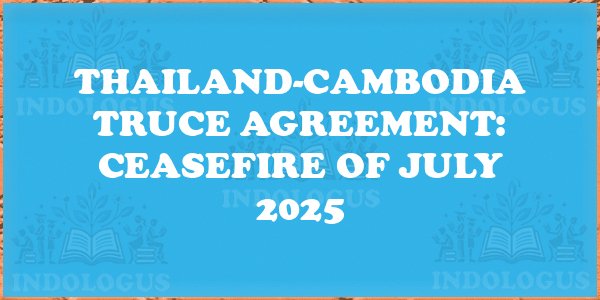The Thailand–Cambodia ceasefire of July 2025 demonstrates the significance of regional diplomacy and international mediation in conflict resolution. While the truce offers relief to thousands of civilians, its success depends on the commitment of both nations.
Overview:
A ceasefire agreement between Thailand and Cambodia took effect on July 28, 2025, marking the end of a five-day border battle that killed at least 38 people, mostly civilians, and displaced over 300,000 residents.
What is Truce Agreement?
A truce agreement is a formal arrangement between opposing parties in a conflict to temporarily stop fighting, usually for a specific period of time and in a specific area. It does not end the war or conflict permanently but serves as a pause in hostilities for negotiations, humanitarian aid, or peace talks to take place.
Key Points about a Truce Agreement
- Temporary Halt: It suspends fighting but does not resolve the root causes of conflict.
- Not a Peace Treaty: It does not legally end the state of war.
- Humanitarian Purpose: Allows evacuation of civilians, medical aid, or prisoner exchanges.
- White Flag Protection: Those with a white flag are protected; misuse is a war crime.
- Historical Use: Before the UN Charter, terms like truce, armistice, and peace treaty were distinct.
Background of the Conflict
The Thailand–Cambodia border has been a source of territorial disputes, with tensions escalating since the killing of a Cambodian soldier in May 2025, leading to troop buildups.
Mediation Efforts
- The ceasefire was brokered in Putrajaya, Malaysia, mediated by Malaysian Prime Minister Anwar Ibrahim.
- U.S. President Donald Trump played a critical role, linking peace to trade talks.
- China pushed for dialogue, and the agreement included establishing a monitoring mechanism.
Humanitarian Impact
- Houses in Sisaket province (Thailand) were destroyed by artillery.
- Civilians sought refuge in evacuation centers, with reports of food distribution and separated families.
- Residents expressed a strong desire to return home once safety was assured.
Key Takeaways for Competitive Exams
- Understanding truce agreements as temporary halts in conflicts.
- Recognizing the humanitarian purposes and protections during truces.
- Appreciating the role of international mediation in resolving conflicts.
- Acknowledging the impact of conflicts on civilian populations and the need for swift resolutions.



